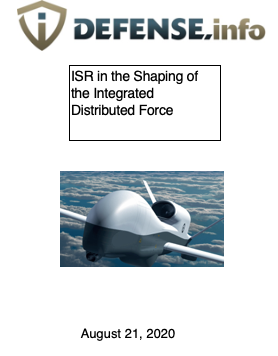ISR for the Integrated Distributed Force
Over the past thirty years, the United States and its core allies have gone through three phases of innovation with regard to conventional forces.
The first was air-land battle designed for the European theater and executed in the 1991 Iraqi War.
The second was the innovations associated with the land wars and the joint force support for COIN operations.
The third which is unfolding now is designed to deal with 21st century high intensity operations which can be conducted by peer competitors.
This new phase might be called shaping, exercising and building an integrated distributed force.
This entails interactive technological, force structure and geographical deployment dynamics. We have argued that a new basing structure combined with a capability to deploy and operate an integrated distributed force is at the heart of the strategic shift, and not only in the Pacific.
This is a key part of the effort to shape a full spectrum crisis management capability whose con-ops is shaped to deal with adversary operations within what some call the “gray zone” or within the “hybrid warfare” area.
The nature of the threat facing the liberal democracies was well put by a senior Finnish official: “The timeline for early warning is shorter; the threshold for the use of force is lower.”
What is unfolding is that capabilities traditionally associated with high end warfare are being drawn upon for lower threshold conflicts, designed to achieve political effect without firing a shot.
Higher end capabilities being developed by China and Russia are becoming tools to achieve political-military objectives throughout the diplomatic engagement spectrum.
This means that not only do the liberal democracies need to shape more effective higher end capabilities but they need to learn how to use force packages which are making up a higher end, higher tempo or higher intensity capability as part of a range of both military operations but proactive engagement to shape peer adversary behavior.
In today’s world, this is what full spectrum crisis management is all about. It is not simply about escalation ladders; it is about the capability to operate tailored task forces within a crisis setting – to dominate and prevail within a diversity of crises which might not be located on what one might consider an escalation ladder.
The reworking of ISR is a key element in building out such a force.
For a PDF version of the report, see the following:
ISR for the IDFFor an ebook version of the report, see below:

